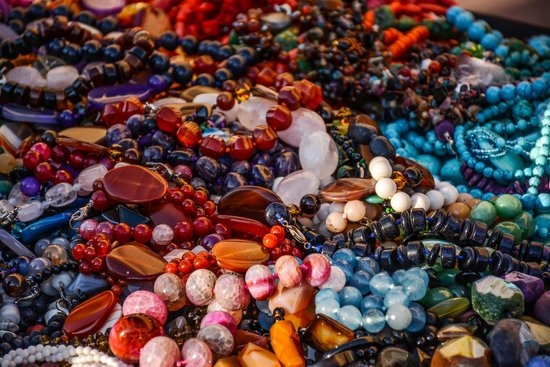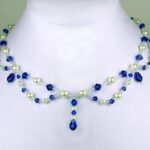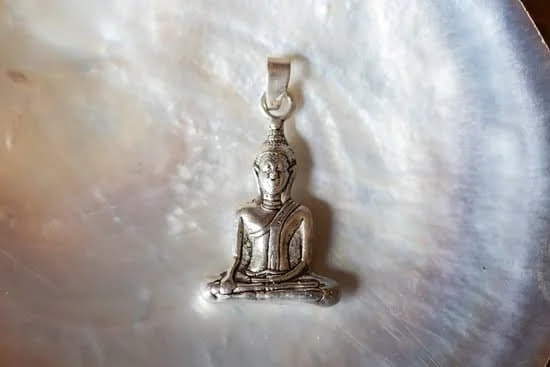Fine jewelry holds a special place in the world of fashion, captivating enthusiasts with its exquisite craftsmanship and timeless allure. In this article, we will delve into the fascinating journey of how fine jewelry is made, uncovering the intricate processes involved in creating these beautiful pieces that have become synonymous with luxury and prestige.
Firstly, it is important to define what exactly constitutes fine jewelry. Unlike costume or fashion jewelry, which are often produced with non-precious materials, fine jewelry is crafted using precious metals and gemstones. This distinction signifies not only the superior quality and longevity of fine jewelry but also its elevated status within the fashion industry.
The significance of fine jewelry in the world of fashion cannot be overstated. Fine jewelry serves as both an expression of personal style and a symbol of wealth and success. Whether it is a dazzling diamond necklace worn on a red carpet or an heirloom piece handed down through generations, fine jewelry has continually captivated admirers for centuries. Its ability to elevate any outfit and add that touch of refinement makes it an integral part of the fashion industry.
Now let us embark on a journey into the mesmerizing world of how fine jewelry is made. From selecting the finest precious metals to sourcing and evaluating radiant gemstones, each step in the process requires exceptional skill, precision, and attention to detail. Join us as we explore each stage in this enchanting process and gain insight into the dedication that goes into crafting these exquisite pieces.
A Glimpse into the World of Precious Metals
The Importance of Precious Metals in Fine Jewelry
One of the key components of fine jewelry is the use of precious metals, which adds value and durability to each piece. Gold, silver, platinum, and other precious metals are highly sought after for their beauty and rarity. These metals provide the foundation for jewelry making, showcasing the craftsmanship and creativity of designers.
Gold is one of the most popular precious metals used in fine jewelry production. Its versatility allows it to be transformed into various colors such as yellow gold, white gold, and rose gold. Additionally, gold is known for its resistance to corrosion, making it an ideal material for long-lasting pieces. Silver is another widely used metal in fine jewelry due to its affordability and malleability. Platinum, on the other hand, is favored for its strength and purity.
Sourcing and Refining Precious Metals
The process of creating fine jewelry with precious metals begins with sourcing and refining these materials. Mining companies extract these valuable metals from mines worldwide through a meticulous process that involves blasting rocks, drilling holes, and extracting ore. Once the raw minerals are obtained, they undergo a refining process to remove impurities and enhance their purity.
Hallmarking plays a crucial role in determining the quality and authenticity of precious metals used in jewelry making. Hallmarks are small marks or stamps that indicate the metal’s purity level and certifications from regulatory bodies. For example, in the United States, karat markings such as 14K or 18K are used to denote gold’s purity percentage.
The Significance of Quality Certifications
In addition to hallmarking, quality certifications also play a significant role in verifying the authenticity of precious metals used in fine jewelry making. Organizations such as the Responsible Jewellery Council (RJC) ensure that ethical practices are followed throughout the supply chain process – from mining to manufacturing – promoting sustainability and responsible sourcing of precious metals.
Certifications like the Kimberley Process Certification Scheme (KPCS) are particularly important for diamonds, ensuring that they are conflict-free. The 4Cs – cut, color, clarity, and carat weight – serve as a grading system for diamonds, providing consumers with an objective evaluation of their quality.
The Intricate Art of Gemstone Selection
Gemstones play a crucial role in the creation of fine jewelry, adding beauty, color, and sparkle to the final pieces. The process of gemstone selection is intricate and requires careful consideration to ensure that only the highest quality stones are chosen.
There are various types of gemstones used in fine jewelry, including diamonds, emeralds, sapphires, and rubies. Each type has its own unique characteristics and allure. Diamonds are known for their brilliance and durability, making them a popular choice for engagement rings and other statement pieces.
Emeralds are prized for their vibrant green color and are often associated with luxury and elegance. Sapphires come in a range of colors but are most commonly associated with deep blue tones. Rubies, on the other hand, are known for their rich red hue and symbolize passion and love.
When selecting gemstones for fine jewelry, several factors come into play. Color is one of the most important considerations, as it greatly affects the overall appearance of the piece. Gemstones with vivid and intense colors are typically preferred over those with lighter or duller hues. Clarity refers to the presence of any internal flaws or inclusions within the stone. The higher the clarity grade, the more valuable and desirable the gemstone is considered to be.
Cut plays a significant role in enhancing a gemstone’s beauty as it determines how light interacts with the stone. Well-cut gemstones will reflect light back to the viewer’s eye, creating maximum brilliance and sparkle. Lastly, carat weight refers to a gemstone’s size, with larger stones generally being more valuable.
The process of sourcing and evaluating gemstones is critical to ensuring their quality and authenticity in fine jewelry production. Ethical sourcing practices should be followed to ensure that gemstones are obtained without causing harm to people or the environment. Reputable jewelers often work closely with trusted suppliers who adhere to responsible sourcing standards.
| Gemstone Type | Characteristic |
|---|---|
| Diamonds | Brilliance, durability |
| Emeralds | Vibrant green color |
| Sapphires | Range of colors; commonly deep blue |
| Rubies | Rich red hue; symbolize passion and love |
From Sketch to Reality
Designing Fine Jewelry:
Designing fine jewelry is a crucial step in the creation process, as it is where ideas and concepts come to life. Jewelry designers play a vital role in transforming sketches and visions into tangible pieces of art that can be worn and appreciated. This section explores the process of designing fine jewelry, from the initial sketches to utilizing modern technology for precision and creativity.
The first step in designing fine jewelry typically involves sketching and conceptualizing ideas. This allows designers to explore different shapes, forms, and aesthetics for their jewelry pieces. Sketches provide a visual representation of the designer’s vision, allowing them to communicate their ideas effectively.
However, with advancements in technology, many designers now utilize computer-aided design (CAD) software and 3D modeling programs. These tools offer more precision and allow for intricate detailing. CAD software enables designers to create virtual models of their designs, which can help them assess the visual appeal and feasibility before progressing further.
Once the design concept is finalized, the next step is transforming it into a physical piece of jewelry. This involves various techniques such as wax carving or 3D printing to create prototypes or molds that serve as the basis for production. These prototypes are often referred to as “master models” and act as a guide for casting or fabrication.
Aesthetics are not the only consideration when designing fine jewelry; functionality is equally important. Jewelry needs to be comfortable to wear while also being structurally sound. Designers need to consider factors such as weight distribution, durability of materials chosen, and how pieces will hang on a body when creating their designs.
In terms of style trends, there are countless variations within the world of fine jewelry design. Some designers may lean towards minimalist styles with clean lines and simplicity, while others may opt for bold statement pieces adorned with elaborate gemstone arrangements.
Overall, designing fine jewelry requires a unique blend of creativity, technical knowledge, and an understanding of the wearer’s desires. It is a collaborative effort between the designer, craftspeople, and often the client to create something that embodies both beauty and functionality.
| Traditional Sketching | Modern CAD Techniques |
|---|---|
| Hand-drawn sketches provide a tangible representation of design ideas. | CAD software allows for precise and detailed virtual modeling. |
| Ideas can be quickly explored and modified on paper. | Designs can be easily manipulated, modified, and assessed digitally. |
| Sketches are open to interpretation and may require additional communication to ensure all details are understood. | Virtual models offer clarity and provide clear visual references for further steps in the production process. |
Mastering the Art of Jewelry Crafting and Techniques
Fine jewelry is not just about the precious metals and gemstones used, but also the craftsmanship and techniques employed in its creation. This section will delve into the intricate art of jewelry crafting and highlight the skills required to bring these exquisite pieces to life.
One of the key aspects of jewelry crafting is understanding and mastering a variety of techniques. Traditional techniques such as casting, soldering, stone setting, and engraving have been refined over centuries and continue to be employed today. These techniques require precision, patience, and a keen eye for detail. Each stage of the process must be executed flawlessly to create a piece that meets the highest standards of quality.
In addition to traditional techniques, modern technology has also revolutionized jewelry making. Computer-aided design (CAD) has allowed designers to create intricate digital models that can be turned into physical objects using 3D printing or CNC milling. This fusion of traditional craftsmanship with cutting-edge technology allows for greater complexity and innovation in design.
The role of experienced craftsmen and artisans cannot be overstated in the creation of fine jewelry. Their expertise is essential in bringing designs to life and ensuring that every aspect is meticulously crafted. These skilled professionals work diligently to ensure that every stone is securely set, every surface is flawlessly polished, and every detail enhances the overall design.
Mastering the art of jewelry crafting requires years of practice, training, and refining one’s skills. It is through countless hours spent honing their craft that jewelers are able to create truly stunning pieces that capture the imagination. The dedication and passion displayed by these craftsmen contribute to the allure and prestige associated with fine jewelry.
The Finishing Touch
The process of polishing is a crucial step in the creation of fine jewelry, as it enhances the final appearance and allure of each piece. Polishing involves refining the surface of the metal to achieve a smooth and lustrous finish. This step not only adds a brilliant shine but also highlights the intricate details and design elements of the jewelry. There are different polishing techniques and tools used in the jewelry industry to achieve various finishes.
- Tumbling: Tumbling is a common method used for polishing jewelry, especially pieces with intricate filigree work or delicate gemstone settings. Jewelry components are placed in a rotating drum or barrel along with polishing agents such as ceramic beads or walnut shells. The continuous movement helps to remove any surface imperfections and leaves the jewelry with a polished finish.
- Buffing: Buffing is another popular technique that involves using soft buffing wheels made of materials like felt or muslin, which are coated with polishing compounds. The jeweler carefully manipulates the piece against these wheels to gently remove any scratches or blemishes while creating a high-gloss finish.
- Ultrasonic Cleaning: In addition to traditional polishing techniques, jewelers also employ ultrasonic cleaning methods to remove dirt, oils, and other contaminants from jewelry surfaces. Ultrasonic cleaners use high-frequency sound waves in a specialized cleaning solution to dislodge and eliminate particles that may have accumulated during the manufacturing process.
Alongside the various polishing techniques, jewelers often utilize different types of surface finishes to enhance both aesthetics and texture.
- High Polish Finish: A high polish finish is achieved by intensively buffing the metal until it reflects light brilliantly. This finish is commonly used in classic and contemporary jewelry designs and adds a glamorous and luxurious touch to the piece.
- Matte Finish: The matte finish creates a more subdued and velvety appearance by reducing the reflectivity of the metal surface. It is achieved through sandblasting, brushing, or using abrasive materials on the jewelry.
- Brushed Finish: Brushed finishes create delicate parallel lines or fine textures on the metal surface. This technique involves using abrasive tools like wire brushes or sandpaper to achieve a soft, satin-like effect.
Besides polishing and finishes, another important consideration in fine jewelry production is plating. Plating involves adding a layer of metal, such as gold, silver, or rhodium onto the surface of the jewelry for added durability, protection against tarnishing, and aesthetic purposes. This can be done through processes like electroplating or vacuum plating.
Ultimately, the attention to detail given during the finishing stage contributes significantly to the overall quality and beauty of fine jewelry pieces. The meticulous polishing techniques and high-quality finishes applied by skilled artisans ensure that each creation reaches its full potential while captivating wearers with their dazzling presence.
Quality Control and Certification in Fine Jewelry Making
When it comes to fine jewelry, quality control is of utmost importance. The meticulous craftsmanship involved in creating each piece requires stringent measures to ensure that the final product meets the highest standards of excellence. In order to provide assurance to consumers, certifications play a crucial role in verifying the authenticity, quality, and ethical production practices of fine jewelry.
One significant certification for diamonds is the 4Cs, which stands for cut, color, clarity, and carat weight. This grading system provides a standardized way of evaluating and communicating the quality of diamonds. The cut refers to how well a diamond has been shaped and faceted, impacting its brilliance and sparkle.
Color assesses the presence of any tints or undertones in a diamond, with colorless stones being highly valued. Clarity rates the presence of any internal flaws or external blemishes within a diamond. Lastly, carat weight measures how much a diamond weighs.
Aside from diamonds, other gemstones used in fine jewelry also undergo certification processes to authenticate their quality. Gemological laboratories evaluate gemstones based on their color properties, clarity features, cut quality, origin disclosure (for responsibly sourced stones), treatments (if any), and overall integrity. These certifications provide confidence to consumers about the genuineness and value of the gemstones used in their precious jewelry pieces.
Another important aspect of quality control in fine jewelry making is ensuring ethical production practices. Responsible sourcing of precious metals and gemstones has become increasingly significant for both consumers and industry professionals alike. Certifications such as Fairtrade Gold and Responsible Jewellery Council (RJC) certifications reassure buyers that their jewelry has been produced with respect for human rights, labor practices, environmental sustainability, and traceability.
In addition to certifications, warranties and guarantees offered by reputable jewelry brands further contribute to consumer trust. These assurances provide peace of mind that if there are any issues or defects with the purchased fine jewelry, the brand will take appropriate measures to rectify the situation. The length and coverage of these warranties vary by brand, but they generally protect against manufacturing defects and workmanship issues.
Overall, quality control and certification go hand in hand in the world of fine jewelry making. By adhering to strict standards and obtaining certifications, jewelers demonstrate their commitment to craftsmanship, ethical practices, and consumer satisfaction. These measures not only ensure the authenticity and quality of fine jewelry but also elevate its value as a cherished piece that can be passed down through generations.
Bringing Fine Jewelry to Market
Once the intricate process of designing and crafting fine jewelry is complete, the next step is to bring these exquisite pieces to the market. This section explores the journey of fine jewelry from the workshop to the hands of consumers, highlighting the various distribution channels and retail platforms involved.
1. Direct-to-Consumer Sales:
In recent years, there has been a noticeable shift towards direct-to-consumer sales in the fine jewelry industry. This method allows jewelry brands to connect directly with their customers through their own e-commerce websites or physical stores. By eliminating middlemen, brands can offer competitive prices while maintaining control over their brand image and customer experience.
2. Wholesale:
Wholesale remains a popular distribution channel for many fine jewelry brands. In this model, jewelers sell their collections to retailers in bulk at discounted prices who then resell them to consumers through their own stores or online platforms. This approach allows for wider brand exposure and access to diverse consumer markets.
3. Retail:
Retail stores are still an essential part of selling fine jewelry. From high-end boutiques to department stores, retail spaces offer customers a physical location where they can see, touch, and try on different pieces before making a purchase. Retailers often curate a selection of fine jewelry from various brands, catering to different styles and price points.
4. Jewelry Exhibitions and Trade Shows:
Jewelry exhibitions and trade shows provide a platform for designers and brands to showcase their collections to industry professionals as well as potential buyers. These events allow for networking opportunities, collaboration possibilities, and exposure to new markets both domestically and internationally.
5. Online Platforms:
The digital era has revolutionized the way people shop for fine jewelry. Online platforms provide convenience and accessibility to consumers globally by offering a vast selection of designs from different brands in one place. E-commerce giants like Amazon and specialized online retailers like Blue Nile have become popular destinations for purchasing fine jewelry.
Pricing Factors:
The pricing of fine jewelry is influenced by several factors, including the craftsmanship involved in its creation, the quality and rarity of materials used, and the reputation of the brand. Fine jewelry often carries a higher price tag due to the use of precious metals, gemstones, and intricate design techniques. Additionally, established luxury brands command higher prices due to their brand prestige and exclusivity.
Conclusion
In conclusion, the art and craftsmanship behind fine jewelry is truly remarkable. Throughout this article, we have delved into the intricate process of creating these exquisite pieces. From the sourcing of precious metals and gemstones to the design and crafting techniques, every step requires skill, creativity, and attention to detail.
Fine jewelry holds a timeless beauty and value that is unmatched by any other accessory. The allure and prestige associated with these pieces make them highly sought-after in the fashion industry. They are not just accessories; they are symbols of luxury, elegance, and personal style.
It is important for us to appreciate and support the craftsmanship behind each piece of fine jewelry. From master jewelers who have honed their skills over years of practice to the designers who bring these visions to life, their dedication is what makes fine jewelry so special.
When you wear a piece of fine jewelry, you are not just wearing an accessory – you are wearing a work of art. So let us celebrate the artistry and expertise that goes into every creation and continue to cherish these treasures for generations to come.
Frequently Asked Questions
What materials are used in fine jewelry?
Fine jewelry is typically made using high-quality materials such as precious metals like gold, silver, and platinum. These metals are often alloyed to improve their durability and strength.
Additionally, fine jewelry can feature gemstones like diamonds, rubies, sapphires, emeralds, and pearls. These gemstones are carefully selected based on their quality and aesthetics before being set into the metal settings of the jewelry piece.
How is jewelry made step by step?
The process of making jewelry involves several steps that require skill and precision. Firstly, the design of the jewelry piece is created either by hand sketching or using computer-aided design (CAD) software. Once the design is finalized, it is transferred onto a wax mold or directly onto a metal sheet using various techniques.
Next, the metal is shaped and formed according to the design through processes such as cutting, filing, soldering, and polishing. If gemstones are involved in the design, they are carefully set into the metal settings using prongs or other appropriate techniques. Finally, the completed piece undergoes a thorough inspection to ensure its quality before being polished again for a final finish.
Is fine jewelry making profitable?
Fine jewelry making can be profitable if done successfully with careful consideration of several factors. The cost of materials used in fine jewelry can vary significantly depending on factors like the type of metal used and the quality and size of gemstones incorporated into the design. Additionally, skilled craftsmanship is crucial for creating high-quality pieces that appeal to customers who value fine jewelry craftsmanship. Marketing strategies play an important role in attracting potential buyers who appreciate fine craftsmanship and are willing to pay a premium for unique designs.
Retail markups can also contribute to profitability if managed effectively. However, competition within the industry and changing market trends can pose challenges for profitability in fine jewelry making businesses. Successful marketing strategies tailored to target markets with distinctive preferences can help maximize profits in this field.

Welcome to my jewelry blog! My name is Sarah and I am the owner of this blog.
I love making jewelry and sharing my creations with others.
So whether you’re someone who loves wearing jewelry yourself or simply enjoys learning about it, be sure to check out my blog for insightful posts on everything related to this exciting topic!





